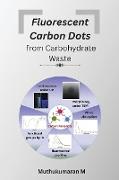Fluorescent carbon dots from carbohydrate waste
BücherAngebote / Angebote:
Fluorescent carbon dots (CDs) are a novel class of fluorescent nanomaterials that have been the subject of much research in recent years. These dots are typically less than 10 nm in size and are composed of carbon, oxygen, and other functional groups. One promising aspect of CDs is their potential application in various fields such as bioimaging, biosensing, and drug delivery due to their unique optical and physicochemical properties.
One promising source for the synthesis of CDs is carbohydrate waste. Carbohydrates are widely found in plants and are an essential source of energy. However, a significant amount of carbohydrates are lost during processing, leading to waste generation. The use of carbohydrate waste for the synthesis of CDs not only provides a sustainable source for these materials but also reduces the environmental impact of waste disposal.
The synthesis of fluorescent carbon dots from carbohydrate waste involves the carbonization of the waste material at high temperatures in the presence of suitable precursors such as ethylenediamine or citric acid. The resulting CDs exhibit excellent photoluminescence properties and are highly stable. Furthermore, the surface chemistry of the CDs can be easily modified by introducing functional groups that can be used for various applications.
One potential application of fluorescent carbon dots from carbohydrate waste is in electrochemical sensing. Electrochemical sensors are used to detect various analytes in biological and environmental samples. CDs can be used as a sensing platform due to their unique optical properties and their ability to act as electron donors or acceptors in electrochemical reactions. Additionally, the surface chemistry of CDs can be modified to enhance their selectivity and sensitivity towards specific analytes.
Another potential application of fluorescent carbon dots from carbohydrate waste is in biological studies. CDs have been shown to be biocompatible and can be used for bioimaging applications. The small size and excellent photoluminescence properties of CDs make them ideal for use in cellular imaging and tracking. Furthermore, the surface chemistry of CDs can be modified to enhance their cellular uptake and targeting towards specific cells or tissues.
In conclusion, fluorescent carbon dots synthesized from carbohydrate waste offer a sustainable and environmentally friendly source of fluorescent nanomaterials with potential applications in various fields such as electrochemical sensing and biological studies. The unique properties of these materials and their facile synthesis make them an attractive candidate for further research and development.
Folgt in ca. 15 Arbeitstagen




